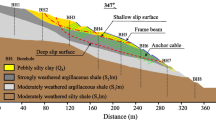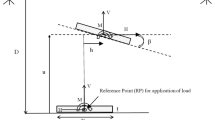Abstract
The collapse of tied-back excavations frequently occurs due to anchor failures. However, the mechanism by which the anchor failure evolves to a large-scale collapse of the excavation has seldom been studied. To investigate the progressive collapse mechanism of anchored pile excavations, the finite difference method was adopted to carry out anchor failure simulations. In single-level anchored pile excavation, failure of anchors would lead to an obvious increase in axial forces in 3–4 adjacent anchors. When the number of failed anchors was low, the failure path developed in the anchors, and the bending moments of the piles in the failure zone decreased. When the number of failed anchors was greater than a certain number, the piles in the failure zone gradually became cantilevered and failed, which indicates that the failure path was transferred to the piles. In multi-level (such as two or three levels) anchored pile excavation, the partial failure of the first-level anchors has a great impact on the adjacent anchors, and causes the pile bending moments to decrease, while the partial failure of the lowest-level anchors has the opposite effects. The impact of partial failure of only one-level anchors in a multilevel anchored pile system was less than that in a single-level anchored pile system with the same excavation depth. However, the impact of column-anchor failure in a multi-level anchored pile system was significantly greater than that of a single-level anchored pile system, which easily led to progressive collapse. Therefore, construction or design methods, such as the interval level anchor strengthening method, should be adopted to limit the partial failure in a certain level. Anchor failure in a single-level anchor-pile system or column-anchor failure in a multi-level anchored pile system easily led to damage to the capping beam and waler beam. Then it would cause pile failure and accelerate the excavation collapse process. Therefore, the capping (waler) beam should be designed under the column-anchor failure condition to improve the overall safety performance of the retaining system.






















Similar content being viewed by others
Data availability
Data will be made available on reasonable request.
References
Barley AD (1997) The failure of a 21 year old anchored sheet pile quay wall on the Thames. Ground Eng 30:42–45
Cheng XS, Zheng G, Diao Y et al (2017) Experimental study of the progressive collapse mechanism of excavations retained by cantilever piles. Can Geotech J 54(4):574–587
Cheng XS, Zheng G, Diao Y et al (2016) Study of the progressive collapse mechanism of excavations retained by cantilever contiguous piles. Eng Fail Anal 71:72–89
China (2012) Ministry of Housing and Urban-Rural Development, PRC. JGJ120-2012: technical specification for retaining and protection of building foundation excavations
Choosrithong K, Schweiger HF (2018) Influence of individual strut failure on performance of deep excavation in soft soil: volume 1. In: Proceedings of China-Europe conference on geotechnical engineering
Da Silva AP, Festugato L, Masuero JR (2017) A new methodology to assess the structural safety of anchored retaining walls. Thin Walled Struct 117(1):343–355
De Moor EK (1994) Technical note. An analysis of bored pile/diaphragm wall installation effects. Géotechnique 44:341–347
Ding X, Sheng Q, Han J et al (2002) Numerical simulation testing study on reinforcement mechanism of perstressed anchorage cable. Chin J Rock Mech Eng 21:980–988
Duncan JM, Wong-Kai S, Mabry P et al (1980) Strength, stress–strain and bulk modulus parameters for finite element analyses of stresses and movements in soil masses. J Consult Clin Psychol 49(4):554–567
Gálvez J, Elices M, Olivares MA (2006) Damage tolerance of an anchor head in a post-tensioning anchorage system. Eng Fail Anal 13(2):235–246
Goh A, Fan Z, Liu H et al (2018) Numerical analysis on strut responses due to one-strut failure for braced excavation in clays. In: Proceedings of the 2nd international symposium on Asia urban geoengineering
Haack A (2010) Construction of the north-south-metro line in Cologne and the accident on March 3rd, 2009. Soc Soc Manage Syst Internet J 6(1):SMS10–194
Hsu ST (2012) Behavior of pressure-grouted anchors in gravel. Can Geotech J 49(6):719–728
Itoh K, Kikkawa N, Toyosawa Y et al (2011) Failure mechanism of anchored retaining wall due to the anchor head itself being broken. In: Proceeding of Tc302 symposium Osaka: international symposium on backwards problem in geotechnical engineering & monitoring of geo-construction
Jeong SS, Kim YH, Kim MM (2016) Failure case study of tieback wall in urban area, Korea. Springer India, New Delhi
Jiang Q, Feng XT, Cui J et al (2015) Failure mechanism of unbonded prestressed thru-anchor cables: in situ investigation in large underground caverns. Rock Mech Rock Eng 48(2):873–878
Leong EC, Leung CF (2012) Applications of technical reference for deep excavation TR26: 2010. IES J Part A Civ Struct Eng 5(3):129–130
Li YY, Zhang DL, Zhang HB et al (2010) Research on failure mechanism and effects of prestressed anchor cables for reinforcing slopes. Rock Soil Mech 31:144–149
Littlejohn GS (1987) Ground anchorages: corrosion performance. Ice Proc 82(3):645–662
Marjanishvili SM (2004) Progressive analysis procedure for progressive collapse. J Perform Constr Facil 18(2):79–85
Parry-Davies R, and Knottenbelt EC (1997) Investigations into long-term performance of anchors in South Africa with emphasis on aspects requiring care. Proceedings of international symposium on ground anchorages and anchored structures. 384-392.
Peck RB, Hanson WE, Thornburn TH (1953) Foundation engineering. Soil Sci 75(4):73–75
Pong KF, Foo SL, Chinnaswamy CG et al (2012) Design considerations for one-strut failure according to TR26—a practical approach for practising engineers. IES J Part A Civ Struct Eng 5:166–180
Stille H, and Broms BB (1976) Load redistribution caused by anchor failures in sheet pile walls. Proceedings of the 6th European conference on soil mechanics and foundation engineering, Vienna, 197–200
Wang Y, Ren A, Wang Y et al (2015) Investigations on corrosion and mechanical properties of a 20-year-old ground anchor exhumed at a power station site. Can Geotech J 53:589–602
Weerasinghe RB, Littlejohn GS (1997) Uplift capacity of shallow anchorages in weak mudstone. Thomas Telford, London
Zhao W, Han JY, Chen Y et al (2018) A numerical study on the influence of anchorage failure for a deep excavation retained by anchored pile walls. Adv Mech Eng 10(2):168781401875677
Zheng G, Lei W, Cheng XS et al (2020) Experimental study on the progressive collapse mechanism in the braced and tied-back retaining systems of deep excavations. Can Geotech J 54:574–587
Acknowledgements
This research was funded by the Project of the National Natural Science Foundation of China (No. 52178343), the Research and Development Program of China Construction Second Engineering Bureau LTD (91110000100024296D200003), and the Research and Development Program of China State Construction Engineering Corporation LTD (CSCEC-2021-Z-25). Their support is gratefully acknowledged.
Author information
Authors and Affiliations
Corresponding author
Additional information
Publisher's Note
Springer Nature remains neutral with regard to jurisdictional claims in published maps and institutional affiliations.
Rights and permissions
Springer Nature or its licensor (e.g. a society or other partner) holds exclusive rights to this article under a publishing agreement with the author(s) or other rightsholder(s); author self-archiving of the accepted manuscript version of this article is solely governed by the terms of such publishing agreement and applicable law.
About this article
Cite this article
Zheng, G., Wang, R.Z., Cheng, X.S. et al. Mechanism and control of progressive collapse of tied-back excavations induced by local anchor failure. Acta Geotech. 19, 763–781 (2024). https://doi.org/10.1007/s11440-023-01930-4
Received:
Accepted:
Published:
Issue Date:
DOI: https://doi.org/10.1007/s11440-023-01930-4




